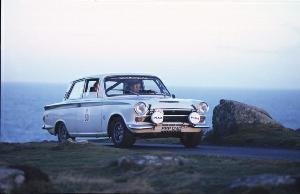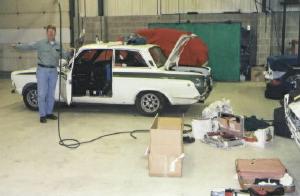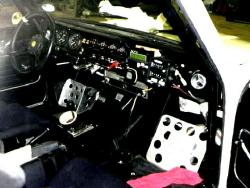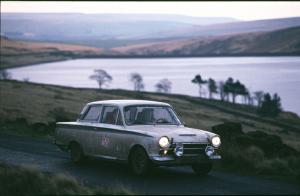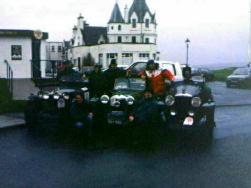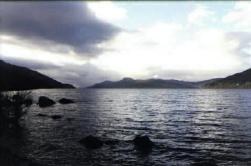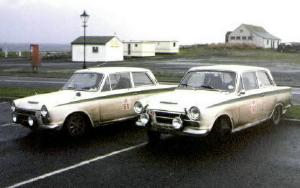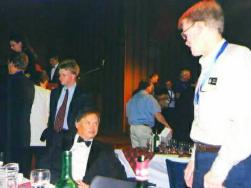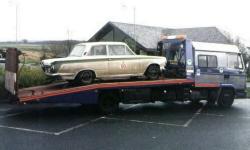
January 2001
A True Reliability Trialby Harry Ward; navigator car #50
Not impressed? Most normal folks are not either. But on December 2, about 100 crews began the 2000 version of the LE JOG; officially known as The Land’s End to John O’Groats Reliability Trial for Historic and Classic Cars. Eric Jones and I were the only Americans to attempt this uniquely British event. First held in 1993, the LE JOG was created by John Brown, a legendary British co-driver from the 60’s and the 70’s. He wanted to re-create a rally similar to the international rallies of the 50’s and 60’s, before stages were introduced; one where relentless endurance and reliability were key, and no service crews were allowed. He would utilize some of the classic rally roads used on the old Motoring News Championship series, especially in Wales and Scotland. Brown created the Historic Endurance Rallying Organisation (HERO) to put rallies such as these together.
The format is based around the British tradition of map reading. All Navigation sections, and many of the Regularities, require navigators to plot a course using such arcane information as map grid references and "spot heights" (a precise elevation noted on the map). The UK is blessed with very accurate Ordinance Survey maps, and these are the basis for the complete route. All instructions are very cryptic; the basic course (less the Tests, Regularity, and Navigation sections) is supplied about a week in advance. You need to spend several days plotting the basic course before the start. So what is ostensibly a 4-day event turns into a 10-day event, when you include the plotting, the trip to Land’s End, and the return trip from John O’Groats.
But we decided to do a couple of things differently for 2000. First, we rented a car ---a stage prepared 1966 Lotus Cortina, as it turned out. While it was actually cheaper to ship Eric’s MG to the UK than to rent the Cortina, the hassle and extra time required to ship a car just is not worth it. Besides, running the LE JOG requires lots of paperwork and supplies. There is not enough room in an MGB to do the work, and store all your "stuff", effectively. The Cortina fit these requirements nicely. As it turned out, having a stage prepared car was beneficial. The second thing we did was to rerun some of the 1999 LE JOG Welsh roads, before the 2000 event started. We chose roads that would not be used in 2000, since practice is illegal. This not only "calibrated" us to the type of roads that we would be using, but also helped me understand where I had made mistakes reading the maps in 1999.
It is hard to describe what the roads in Wales and Scotland are really like. For those of you familiar with some of the old Press On Regardless rally roads in Michigan, Eric described Wales as: "200 miles of Gozzahopper". One infamous road north of Abergwesyn is affectionately called "the Devil’s Staircase". The way it twisted along the edge of steep crevasses reminded me of the Spider Lake stage from the Olympus rally; except in Wales the road is paved, and narrower! Racing through these kinds of roads at night made me glad we had a stage prepared car, although many of the British competitors had nothing more than a skid pan. This year’s event had 20 Tests (0.25 mile to 4.50 mile), 11 Regularities (11.82 mile to 76.16 mile), and 4 Navigation sections (27.8 mile to 73.8 mile). The LE JOG classification system is very complex. It is designed to allow cars of different ages and displacements to compete with each other. Cars are divided into classes by age, and then further divided by engine displacement. The oldest cars (before 1941) maintain slower speeds, run a partially different (and easier) route, and do little reversing on the Tests. The cars made after 1959 have the highest set speeds, and the most difficult course. The cars made between 1941 and 1959 have a course and speeds between the two. Competition is both relative and absolute. On Regularities, the deviation from perfect time is absolute. On Tests, the comparison is within engine displacement class. On Navigation sections, the comparison is within age category. The course design and the various speeds involved make the scoring very difficult. For final classifications, each type of competition has a set "standard". For Tests it varies between 10 seconds and 30 seconds slower than the fastest car in your class. On Regularities, it is within 60 points/control absolute. And on all Navigation sections combined, you cannot lose more total points than the best in your age category. If you can meet all of these requirements, you earn a Gold medal. If you miss the standard on no more than 5 occurrences, you get a Silver; and if you get to every control within your maximum allotted time, you get a Bronze. If you get to all Main Controls, you get a blue ribbon. It sounds easy, but it is not. This year there was 1 Gold, 7 Silvers, and 3 Bronzes awarded, and only 45 cars of the 100 cars were eligible for blue ribbons. The British time Regularities differently than we do TSD in the states. Whereas we are timed when we CROSS an imaginary line, in the UK you are timed when you "Stop Astride" a line. That means you must run somewhat early, and judge when to stop. If you stop before, or after the line, you are penalized. Also, all controls on LE JOG are "time in is time out". That means you are always late when leaving the control. This year, a new computerized scoring system was used; called the Liege watch system. Each competitor has a special clipboard that holds a computer chip. The marshall hacks your time on a Liege watch. Then he/she presses the watch to the chip on your clipboard, and transfers the time to your chip memory (and at several spots during the rally, the information from your chip is downloaded to a master watch, when is then used to feed a computerized scoring system). The marshal also writes your time manually on the scorecard as a backup. This all takes extra time; time which puts you behind for the next section. If there is a stackup of cars at a control, you may be several minutes late leaving. But that is all part of the competition on LE JOG---no delay slips allowed, no claims for being blocked, and few times to gas up or take a break. The relentless pace is what makes this event so unique.
That got us to Main Control #8. At this point, we were one of only nine cars still running to the "Gold" standard! Here, I was given another Regularity and Navigation section to plot. But this plotting was all on our time--- there was no break here. This is where I made my first real mistake. Regularities and Tests can be run at any time the respective control is open (about a 3 hour window), no matter what your assigned arrival time. So you can start them early or late without penalty. Navigational sections can be started after your assigned arrival time without penalty, BUT you only are allowed a 30 minute maximum lateness from your assigned time at each control. I missed this key distinction, and spend too much time plotting the course. So although we thought we were fine on the first 9 controls of the 3rd Navigation section, in fact we were outside our maximum lateness at each of them. We did not learn about this until the first break the next day at Telford.
By now the controls for the next Regularity had closed. But on LE JOG, if you are able to get to a Main Control at the major halts, you are allowed to continue. At Telford, a 6 hour break was scheduled. We arrived at 5:30 AM; about three hours before our out time. We checked the car (the RAC [the UK equivalent to the AAA] has volunteer repair mechanics that will help the competitors at the major halts), got about 1.5 hours sleep, and started again. This year we were determined to finish.
9:02 AM and we were off again, for a 24 hour leg. True to form, I was given three more Regularities to plot. No rest for the navigator! We were quickly into Scotland, and passed within 10 miles of Lockerbie; which causes us both to pause and remember the PanAm tragedy. Then a Regularity using other old RAC stage roads in the Castle O’er forest. Competitive roads in Scotland are not as plentiful as in England or Wales; but the organizers got the weather to help. The rain came down in sheets. Scotland had had so much rain in the last few weeks that the only run off was down the paved roads! At least it was daylight and we could see the water. Every time we would hit a large puddle, the water would cover the fan belt and alternator, and the charging system would stop for a few minutes. But it always recovered. Some folks were not so lucky, and their rally ended in the pouring rain.
Then 60 miles of brisk motoring into John O’Groats. We arrived at 9:15 AM, to the sound of bagpipes (in the rain, of course). A quick toast, and a few words with the members of the Riley team (three cars built before 1937). (The Riley 12/4 ran the whole event with the top DOWN!) Then some photos to show we had actually finished, and back in the car again. You see, there is no place to stay in John O’Groats; the nearest town with sufficient facilities is Wick, about 20 miles south.
Wednesday we started the long trek back south. Of course the sun was shining now! We decided to leave the main road at Inverness, and follow the rally course back along Loch Ness, to take in the view we had missed. We also planned to meet a friend from the states at Edinburgh that night. Two years in Scotland, and I had not yet seen Edinburgh Castle. The loch was very calm, and I got some good pictures. We had lunch and gas at Fort Augustus, and headed east to get the A9 road. Suddenly, the car jumped out of gear (or so I thought). I shifted to third--nothing; second--nothing. We pulled over and stopped. I looked underneath as Eric put the car in gear. The propshaft turned, but we did not move. Something in the rear axle had broken. We were now 181.5 miles south of John O’Groats, with a dead car. The cell phone we rented for the occasion did not work--too many mountains. A Land Rover stopped and took us to the nearest phone booth. We called the car’s owner. He has RAC "recovery" service. (In the UK, if you have "recovery" service, your disabled car can be trailered from any location to any other location.) About an hour later, the truck showed up. We loaded the car, and were taken to the closest hotel for the night. Eric called our friend, and canceled our evening in Edinburgh. So I still have not seen the castle.
So there you have it. LE JOG 2000 is now history. A most unique event; unlike any other. One that fully lives up to its name as a Reliability Trial. So if you like to stay awake for days at a time, plot courses on strange maps through villages with unpronounceable names, race along narrow roads in old cars, and do it all in the rain or the snow, then LE JOG is for you. It will not be held in 2001, but is scheduled to reappear in 2002. So save your money and start practicing your map reading. I hope to see you there!
| Home | Feature stories | North American Calendar | International Calendar | | Vintage Rally Equipment | Vintage Rally Cars | Organizations | |
